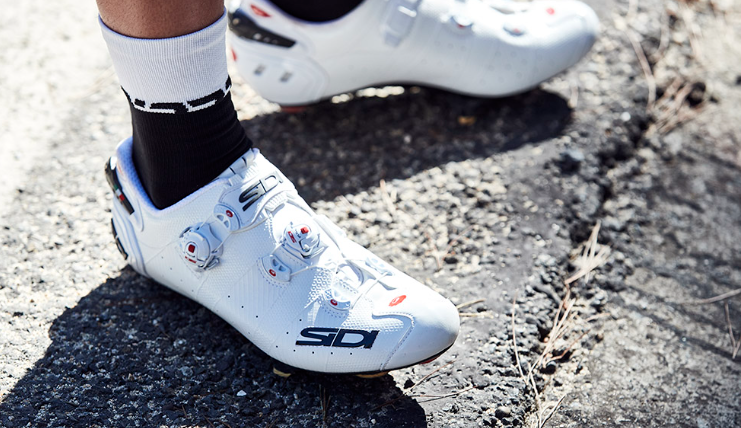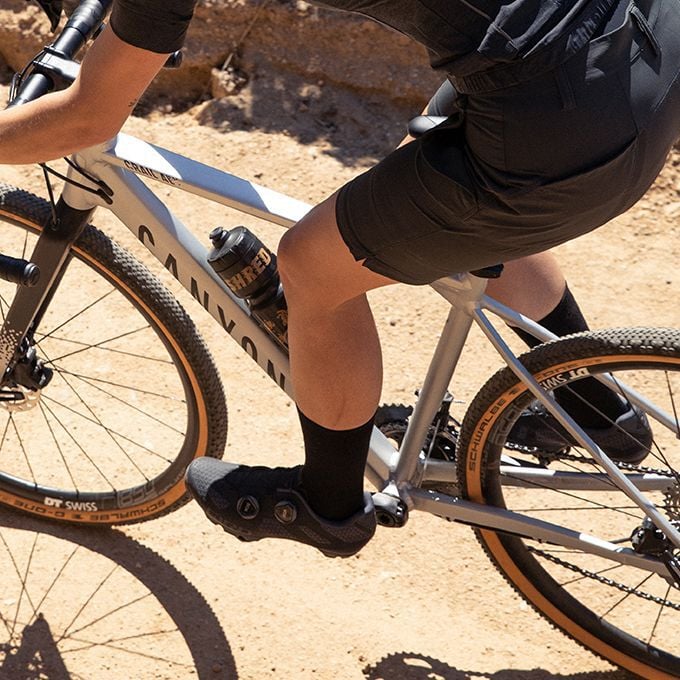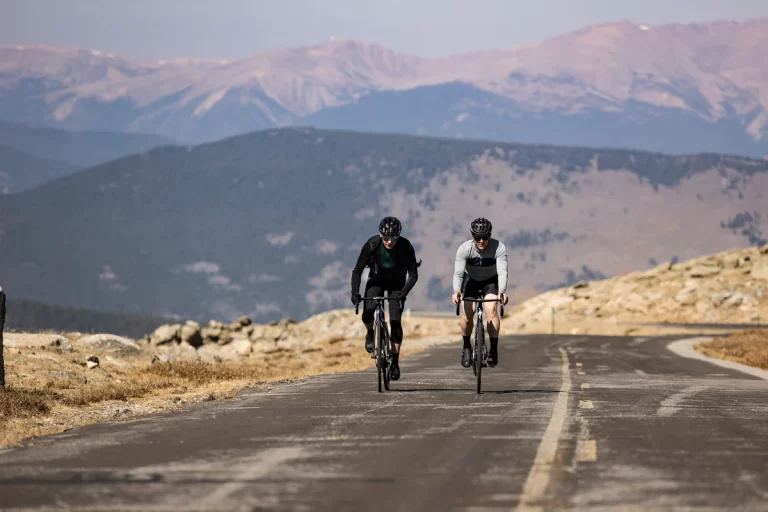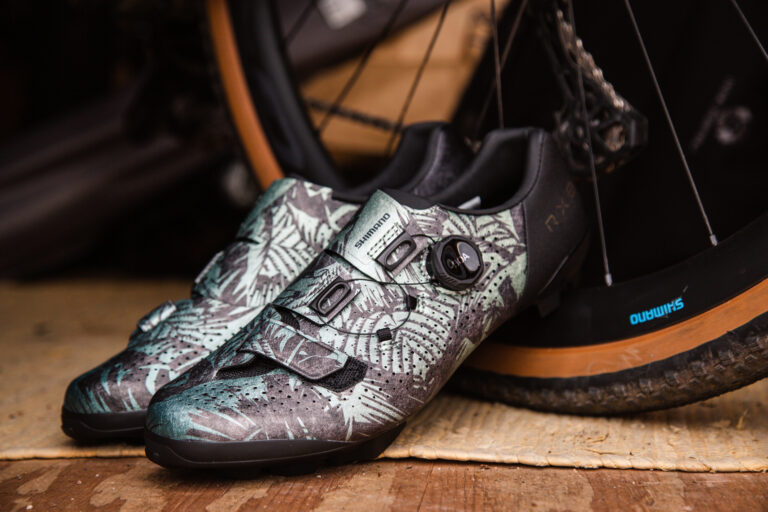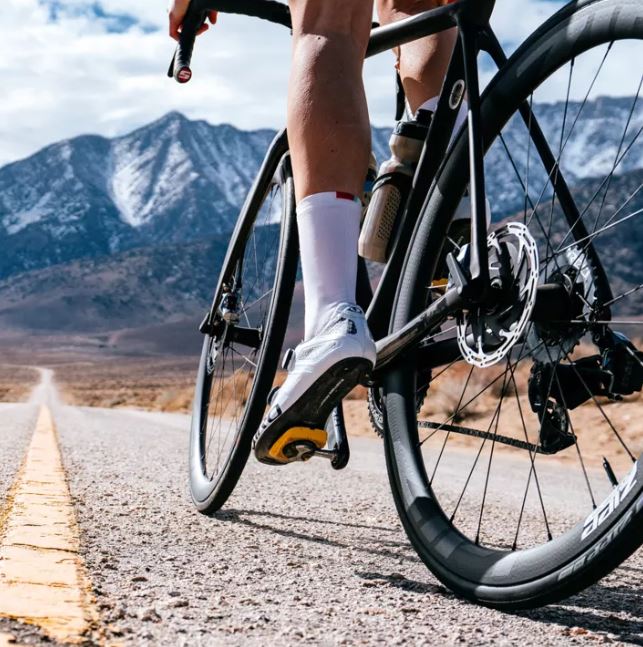Road Bike Shoe Buyers Guide

Introduction
Cycling is a sport where equipment choice can make a significant difference in performance and comfort. One of the most vital components of this equipment is the cyclist’s shoes. Road bike shoes, specifically, serve as the primary connection point between the rider and the bike. In this road bike shoe buyers guide, will take you through everything you need to know about choosing the right road bike shoes.
Understanding the Importance of Riding Type:

- Racing: For those who compete, your shoes can offer the edge you need. Racers often lean towards shoes that prioritize lightweight construction, aerodynamics, and stiffness. These elements translate into faster and more efficient pedaling.
- Long-distance/touring: Riders covering vast distances have different needs. Over hours in the saddle, even a minor discomfort can become problematic. These riders should prioritize shoes that offer optimal comfort, adjustability, and effective ventilation to prevent hotspots and discomfort.
- Casual/commuting: Casual riders and commuters need versatility. They might require a shoe that provides adequate cycling performance but is also comfortable enough to walk in once off the bike.
Achieving the Perfect Fit:

- Size: Just like regular shoes, sizing is paramount in cycling shoes. However, the fit should be snugger than your everyday shoe without causing discomfort. Remember, some brands may fit differently, so always reference the specific brand’s sizing chart.
- Width: The width of cycling shoes can vary. Riders with broader feet should look for models that offer a wider fit to prevent discomfort.
- Arch support: Insoles can be replaced to better match the rider’s foot arch, ensuring better foot support and alignment.
- Ventilation: Adequate airflow can make the difference between a comfortable ride and an unbearable one, especially on warm days. Look for shoes with breathable uppers and ventilation holes in the sole.
Deciphering Closure Systems:

Different closure mechanisms offer varying levels of adjustability and security:
- Laces: A timeless choice, they offer uniform tension across the foot but might not be as easily adjustable mid-ride.
- Velcro Straps: They’re straightforward, effective, and can be adjusted while riding.
- Ratchet Systems: These provide a more locked-in fit, with the added advantage of micro-adjustments.
- BOA Dials: A premium choice, these dials offer precise tension adjustments. They’re incredibly durable and can be tightened or loosened on-the-go.
4. Sole Material and Its Impact:

The sole is the foundation of the cycling shoe:
- Carbon Fiber: Favoured by professionals and enthusiasts alike, carbon soles offer unmatched stiffness. They ensure maximal power transfer, making every pedal stroke count. However, they tend to be pricier.
- Composite: A blend of materials, composite soles balance between stiffness and budget. They’re suitable for a wide range of riders.
- Nylon: Found in more budget-friendly options, they’re slightly more flexible, which might be more comfortable for casual or new riders.
Navigating Pedal and Cleat Compatibility:

Cleat systems connect the shoe to the pedal, ensuring efficient power transfer:
- Three-bolt system: Predominantly used in road cycling shoes. They offer a broad platform for stability and power.
Always ensure that the shoe’s cleat system matches your pedal system. And remember, while some shoes come with cleats, others don’t, meaning a separate purchase might be necessary.
The Weight Factor:
Weight can play a role, especially for racers. Lighter shoes can provide that split-second advantage in sprints and climbs. However, it’s essential to balance weight with features and durability.
Aesthetics:
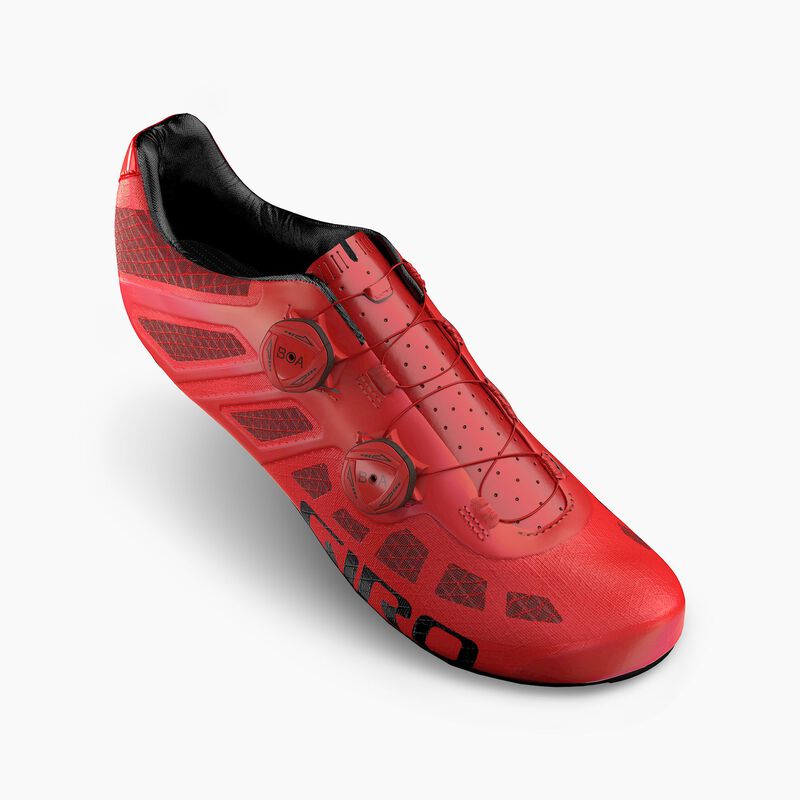
Functionality should always come first, but there’s no harm in wanting to look good on the bike. Many brands offer a range of styles and colors, allowing riders to match their shoes to their bikes or kits.
Weather Adaptability:

Riders who brave varying weather conditions should consider shoes with adaptable features. Waterproof or water-resistant materials, for instance, can be beneficial in wet conditions. Conversely, in hot climates, maximized ventilation becomes critical.
Budgeting for Quality:
Like most things, you often get what you pay for. However, mid-range shoes can offer excellent value, combining essential features with affordability.
Feedback is Your Friend:
Before purchasing, dive into online reviews. They provide real-world insights. Also, don’t hesitate to ask fellow cyclists or local bike shops for recommendations.
The In-Store Advantage:

If possible, always try shoes on in-store. A shoe’s fit can vary between brands and even models. In-store trials allow you to judge comfort, fit, and even the ease of closure mechanisms.
Retention and Support:
A heel cup can prevent foot movement within the shoe, especially when pulling up on the pedals. A secure fit means more direct power transfer and less wasted energy.
Durability Matters:
Regular riders should invest in shoes built to last. Check the construction quality, the durability of the closure system, and the wear resistance of the sole.
Conclusion:
Your road bike shoes serve as the conduit for all your pedaling efforts. The right pair can elevate your cycling experience, providing comfort, efficiency, and even a touch of style. Using this guide, you can navigate the myriad of choices and find the perfect pair for your needs. Remember, in the end, the best shoe is the one that makes every ride enjoyable.
Useful Links
FAQ’s
What shoes should you wear on a road bike?
When riding a road bike, your choice of footwear can greatly affect your comfort, efficiency, and safety. While you can technically ride a road bike with any type of shoe, certain types are better suited for the activity. Here’s what you should consider when choosing shoes for road cycling:
- Cycling Shoes with Cleats: These are the most common type of shoes for road cyclists. They feature a rigid sole that improves power transfer and efficiency. They typically have attachment points for cleats that clip into clipless pedals, ensuring that your foot remains in the optimal position on the pedal.
- Three-bolt system: Most road cycling shoes use a three-bolt system (like the Shimano SPD-SL or Look Delta systems) for attaching the cleat. This design offers a broad platform and increased stability.
- Flat Sole Cycling Shoes: These shoes are typically used with flat or platform pedals. They have a somewhat stiff sole for better power transfer compared to regular sneakers but don’t have cleats. They’re suitable for more casual or urban riding.
- Regular Athletic Shoes: If you’re not interested in clipless pedals or are just starting out, you can use regular athletic shoes with standard pedals or pedals with toe clips and straps. They won’t be as efficient or secure as cycling-specific shoes, but they’ll work for casual rides.
- Other Considerations:
- Ventilation: Proper ventilation helps keep your feet cool during long rides.
- Fit: Ensure that your cycling shoes fit snugly without causing pressure points. Your toes should have a bit of wiggle room, but your heel should be secure and not slip.
- Adjustability: Shoes with multiple velcro straps, ratchets, or dials (like the BOA system) allow for a more customized fit.
- Transitioning to Clipless: If you’re new to clipless pedals and shoes, expect a bit of a learning curve. It’s common for beginners to have a few falls while getting used to clipping in and out. Practice in a safe, low-traffic area until you get the hang of it.
In summary, while you can ride a road bike with any shoe, investing in a good pair of cycling-specific shoes will improve your riding experience, especially if you’re covering long distances or aiming for optimal performance.
How do I know what cycling shoes to buy?
Choosing the right cycling shoes depends on a variety of factors related to your specific needs, the type of cycling you’ll be doing, and personal preferences. Here’s a step-by-step guide to help you determine which cycling shoes are best for you:
- Determine the Type of Cycling You’ll Do:
- Road Cycling: For pure road cycling, opt for lightweight shoes with stiff soles to maximize power transfer. They typically have a smooth, aerodynamic design and use a three-bolt cleat system.
- Mountain Biking (MTB): MTB shoes have a rugged design, offer more foot protection, and use a two-bolt cleat system. These shoes also have a more aggressive tread pattern to help with traction off the bike.
- Touring/Commuting: For long rides or daily commuting, consider shoes that offer a balance between pedaling efficiency and walkability. Some touring shoes resemble casual footwear but still have provisions for cleats.
- Indoor Cycling/Spinning: Many spin bikes use a two-bolt SPD system, but some can accommodate the three-bolt system. Check with your gym or studio to see which type they use.
- Decide on the Pedal/Cleat System:
- Familiarize yourself with the different pedal systems: SPD, SPD-SL, Look, Crank Brothers, etc. The shoes you buy need to be compatible with your pedals.
- Some shoes come with a universal drill pattern that can accommodate both two-bolt and three-bolt cleats, offering flexibility.
- Prioritize Fit and Comfort:
- Measure your foot or have it measured, keeping in mind that cycling shoe sizing can differ from regular shoe sizing.
- Consider the width of your foot. Some brands offer standard and wide-fit versions.
- Your toes should have a bit of wiggle room, but the shoe should fit snugly around the midfoot and heel.
- When trying on shoes, wear the same kind of socks you’ll use for cycling.
- Consider the Shoe’s Closure System:
- Velcro straps are common, easy to adjust, and durable.
- Ratcheting buckles allow for a more precise fit and are typically found on mid-range to high-end shoes.
- BOA dials offer micro-adjustments and are often seen on high-end cycling shoes.
- Evaluate Sole Stiffness and Materials:
- For optimal power transfer, you’ll want a stiff sole, typically made from carbon fiber or reinforced nylon.
- For casual or touring rides, slightly more flex might be comfortable and makes walking easier.
- Additional Features:
- Ventilation: Ensure the shoes have adequate ventilation if you’ll be riding in warm conditions.
- Heel and Toe Treads: Useful for grip when walking.
- Reflective Elements: Helpful for visibility if you’ll be riding in low light.
- Budget: Cycling shoes range widely in price. Determine a budget and try to find the best shoes within that range. Remember, the most expensive shoes aren’t necessarily the best for everyone’s needs.
- Reviews and Recommendations: Before making a final decision, it can be helpful to read reviews or ask for recommendations from fellow cyclists or local bike shops.
- Try Before You Buy: If possible, visit a local bike shop to try on different shoes. The fit and feel can vary significantly between brands and models.
Remember, the right pair of cycling shoes can greatly enhance your riding experience, so it’s worth investing the time to find a pair that fits well and suits your needs.
Should you size up or down in road bike shoes?
When it comes to road bike shoes, getting the correct fit is crucial for comfort, power transfer, and preventing foot problems. Here are some considerations when determining the right size:
- Different Brands, Different Sizes: The fit of cycling shoes can vary between brands and even between models within the same brand. Just because you wear a size 42 in one brand doesn’t mean that a 42 in another brand will fit the same way.
- Swelling: Feet tend to swell during prolonged exercise, especially in warmer temperatures. If you’re on the border between two sizes, this is something to consider. A shoe that feels snug but comfortable at the beginning of a ride might feel tight several hours in.
- Socks Matter: Think about the thickness of the socks you typically wear when cycling. If you wear thicker socks or might layer socks in colder weather, this can affect fit.
- Foot Width: The width of cycling shoes varies between brands and models. Some brands offer regular and wide versions of the same shoe. If a shoe feels too tight width-wise but is the correct length, you might need a wider size or a different brand.
- Fit Tips:
- Your toes should have some wiggle room in the toe box, but not so much that your foot slides forward when pedaling.
- The shoe should fit snugly around the midfoot and heel to prevent any slipping.
- There shouldn’t be noticeable pressure points, which can lead to discomfort or numbness on longer rides.
- Err on the Larger Side (with Caution): If you find yourself in-between sizes, it’s generally safer to size up rather than down. However, avoid getting a shoe that’s too large, as this can lead to inefficient power transfer and potential foot issues.
- Always Try Before You Buy (If Possible): While online shopping is convenient, trying shoes on in a physical store gives you the best sense of fit. Walk around in them and, if the store allows, try them on a stationary bike. This can give you an idea of how they’ll feel when pedaling.
- Return Policies: If you do buy online, check the return policy. Many companies understand the complexities of shoe fit and offer hassle-free returns if the shoes are in like-new condition.
In summary, while the general advice might lean towards sizing up if you’re between sizes, it’s essential to consider the brand, your specific foot shape, intended use, and the factors listed above to make an informed decision
How much difference do road cycling shoes make?
Road cycling shoes can make a significant difference in your riding experience in several ways:
- Power Transfer: The primary advantage of road cycling shoes is the improved power transfer they provide. The stiff soles of these shoes allow for more direct energy transfer from your legs to the pedals. This means that with each pedal stroke, more of your energy is channeled into forward motion, resulting in more efficient cycling.
- Foot Stability: The cleat-pedal interface in road cycling shoes provides a secure connection between the foot and the pedal. This ensures that your foot stays in the optimal position for pedaling, reducing the risk of it slipping off and potentially causing an accident. The consistent foot position can also help in maintaining a more efficient pedal stroke.
- Reduced Fatigue: The rigid structure of road cycling shoes provides a stable platform for your feet. This can reduce muscle fatigue, especially in the foot’s arch, as it doesn’t have to work as hard to maintain its position or grip the pedal.
- Improved Cadence: With a secure connection to the pedal and a consistent foot position, many riders find it easier to maintain a smooth and consistent cadence. This can be particularly beneficial when riding at high speeds or during climbs.
- Protection: Road cycling shoes are designed to protect your feet. The reinforced structure can prevent injuries from minor crashes, flying debris, or when accidentally striking the pedal or ground.
- Aerodynamics: High-end road cycling shoes often incorporate aerodynamic features to minimize drag, especially at higher speeds.
However, there are also some considerations:
- Walking Difficulty: Road cycling shoes, especially those with prominent cleats, can be challenging to walk in. They are often slippery on tile or wood surfaces and can be uncomfortable due to the stiff sole.
- Cost: Quality road cycling shoes can be an investment. However, there are options available at various price points.
- Adaptation Period: If you’re new to using clipless pedals and road shoes, there’s a learning curve involved. Clipping in and out can initially be tricky, and there’s the potential for a few harmless tumbles until you get the hang of it.
In summary, while it’s entirely possible to ride a road bike using regular athletic shoes, road cycling shoes offer advantages that can enhance your performance, comfort, and overall cycling experience. Whether you’re a casual rider or a serious cyclist, investing in a good pair of road cycling shoes can be a game-changer.
Do cycling shoes make a difference?
Yes, cycling shoes do make a difference, especially for those who ride frequently or prioritize performance, comfort, and efficiency. Here’s how cycling shoes can impact your cycling experience:
- Enhanced Power Transfer: Cycling shoes have stiff soles, which means that more of the force you exert on the pedal goes into propelling the bike forward. In contrast, the flexible sole of a typical athletic shoe absorbs some of this force, making your pedal strokes less efficient.
- Foot Stability: Cycling shoes are designed to work with clipless pedal systems. When the shoe is “clipped in” to the pedal, it ensures your foot remains in the optimal position for pedaling, reducing the risk of your foot slipping off the pedal.
- Reduced Fatigue: The rigidity of cycling shoes provides consistent support for your feet, reducing the fatigue in foot muscles over long rides. This is especially noticeable on longer rides or challenging terrains where maintaining efficient pedal strokes is crucial.
- Consistent Pedal Stroke: Being clipped into the pedal allows for a more uniform pedal stroke. You can pull up slightly on the backstroke, making your pedaling more efficient and round.
- Protection: Cycling shoes offer more protection than regular athletic shoes. They are designed to shield your feet from various elements, such as water, debris, and minor impacts.
- Durability: They’re built to endure the specific demands of cycling, which means they’ll typically last longer than a standard athletic shoe when used for riding.
However, there are also a few considerations to keep in mind:
- Walking Comfort: Especially for road-specific cycling shoes, walking can be awkward and uncomfortable due to the protruding cleats and stiff soles. Mountain bike shoes or touring shoes, on the other hand, often have recessed cleats and are more comfortable for walking.
- Cost: Good-quality cycling shoes can be an investment, but there’s a range of options available for different budgets.
- Learning Curve: For those new to clipless pedals and cycling shoes, there can be an initial adaptation period. Clipping in and out takes practice, and there’s a common rite of passage wherein new users might have a stationary fall when they forget to unclip at a stop.
In conclusion, while you can certainly ride a bike without specialized cycling shoes, having them can greatly enhance your efficiency, comfort, and overall riding experience. They’re particularly beneficial for those who cycle regularly or over longer distances.
